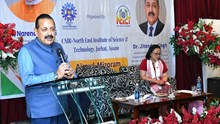
GST Council on Wednesday approved the significant revamp of India’s consumption tax structure, rationalising rates and reducing duties across a wide range of goods, from household essentials and medicines to small vehicles, appliances, and agricultural machinery.
Announced during the 56th meeting chaired by Union Finance Minister Nirmala Sitharaman, the reforms aim to boost domestic spending and ease the economic burden amid global trade pressures. For the agriculture sector, the Council approved GST cuts on farm inputs and mechanisation, making machinery, fertilisers, and allied products more affordable while making farming more affordable, modern and prosperous. Here’s what’s been made cheaper for farmers and the agriculture sector.
Farm Mechanisation Becomes Affordable
GST on several agricultural machinery and equipment has been reduced from 12% to 5%. This includes tractors, harvesting machines, threshers, straw balers, grass or hay mowers, sprinklers, drip irrigation systems, composting machines, and other tools for horticulture, forestry, poultry, or bee-keeping.
Why not fully exempt?
Agricultural machinery was not made fully GST-exempt to maintain a balance between farmers and domestic manufacturers. Full exemption would prevent manufacturers from claiming input tax credits (ITC) on raw materials, raising production costs that could be passed on to farmers.
|
Machinery / Equipment |
Old GST Rate |
New GST Rate |
Impact |
|
Tractors (<1800 cc) |
12% |
5% |
More affordable mechanisation, reduced manual labour costs |
|
Tractor tyres, tubes, hydraulic pumps |
18% |
5% |
Lower maintenance cost for farmers |
|
Sprinklers & drip irrigation systems |
12% |
5% |
Encourages water-efficient farming |
|
Threshers, fodder balers, grass/hay mowers |
12% |
5% |
Boosts shared machinery use via FPOs/cooperatives |
|
Diesel engines (≤15 HP) |
12% |
5% |
Supports small-scale farmers and rural enterprises |
Fertiliser and Agrochemical Inputs
The Council addressed long-standing anomalies in GST on fertilisers. Ammonia, sulphuric acid, and nitric acid GST rates were cut from 18% to 5%, stabilising prices during sowing seasons. Additionally, twelve bio-pesticides and several micronutrients were shifted from 12% to 5%, promoting eco-friendly and natural farming practices.
Food Processing and Dairy Sector Boost
GST on prepared and preserved fruits, vegetables, and nuts has been lowered from 12% to 5%, supporting cold storage infrastructure and reducing post-harvest losses. In the dairy sector, milk and paneer remain exempt, while butter, ghee, and milk cans are now taxed at 5%.
|
Item |
Old GST Rate |
New GST Rate |
Benefit |
|
Butter, Ghee |
12% |
5% |
Affordable dairy products, benefit to women-led rural enterprises |
|
Milk Cans |
12% |
5% |
Lower packaging costs for dairy farmers |
|
Prepared/Preserved Fruits & Vegetables |
12% |
5% |
Reduces food wastage, promotes exports |
Fisheries, Apiculture, and Sustainable Farming
Prepared or preserved fish and natural honey have been brought down to 5%, aiding pisciculture, beekeepers, and tribal communities. Solar-powered irrigation devices and minor forest produce like Kendu leaves now attract just 5% GST, supporting renewable energy use and tribal livelihoods.
Logistics and Supply Chain Efficiency
Transport costs, a key factor in farm economics, have also been addressed. GST on commercial trucks and delivery vans has been reduced from 28% to 18%, while third-party insurance for goods carriers now attracts 5% with ITC benefits. Cheaper logistics will help reduce farm-to-market costs, making produce more competitive domestically and internationally.
The new rates will take effect from September 22. These reforms are expected to accelerate farm mechanization, lower input costs, promote eco-friendly practices, and enhance the competitiveness of India’s agricultural produce. Farmers, cooperatives, and rural enterprises will benefit from reduced GST rates on machinery, inputs, and processed goods, while manufacturers will continue to have the necessary incentives to maintain production efficiency
A Historic Diwali Gift for Farmers!
— Agriculture INDIA (@AgriGoI) September 3, 2025
The Next-Gen GST Reform reduces GST on key agri essentials, bringing rates down to 5% on tractors, agri-machinery, bio-pesticides & irrigation systems, making farming more affordable, modern and prosperous.
Harvesting Growth, Strengthening… pic.twitter.com/OKmgjMCM1F















